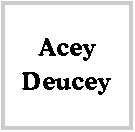 |
. . 1. Acey Deucey |
|
|---|---|---|
| People Involved | 8 dancers | |
| START | parallel waves, 2-faced lines or any formation where all the centers can trade, and the ends can Circulate and not become centers. | |
| END | various | |
| Movement | Ends Circulate while the centers Trade. | |
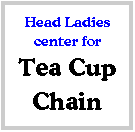 |
. 2. Tea Cup Chain |
|
|---|---|---|
| People Involved | 8 dancers | |
| START | Static Square, or proceeding from everyone doing a Left Arm Turn with partner. | |
| END | Static Square | |
| Movement | The caller will specify two ladies to move to the center at the start of the call, e.g., “Head ladies center for a Teacup Chain”. For the rest of the definition, these two ladies will be called the “specified ladies”. The specified ladies (both Head ladies or both Side ladies) move to the center and Star Right three-quarters to meet their corners for a Left Arm Turn. At the same time, the other two ladies move to the right around the perimeter of the square to their corners, and do a Right Arm Turn. Following the Arm Turns, the specified ladies move around the perimeter of the square to their new corners for a Right Arm Turn, while the other ladies go to the center and Star Left once and a quarter to meet their new corners for a Right Arm Turn. The specified ladies then move to the center and Star Left once and a quarter to their new corners for a Right Arm Turn, while the other ladies move to their new corners (around the perimeter of the square) for a Left Arm Turn. Finally, the specified ladies move to their new corners (their original partners) for either a Courtesy Turn or a Left Arm Turn leading into the next command, while the other ladies move to the center and Star Right three-quarters to meet their new corners (their original partners) for either a Courtesy Turn or a Left Arm Turn leading into the next command. Everyone finishes with his/her original partner. If the caller desires the men to execute the ladies part and vice versa, as described above, the starting formation is a Static Square with all couples half-sashayed, or proceeding from everyone doing a Left Arm Turn with their partner. The proper call is the “Head/Side Men Center for a Teacup Chain”. |
|
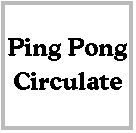 |
. .
3. Ping Pong Circulate
|
|
|---|---|---|
| People Involved | 8 dancers | |
| START | 1/4 tag | |
| END | 1/4 tag | |
| Movement | The movement starts and ends in a Quarter Tag formation. Each dancer Circulates, or moves forward one position along the path shown in Figure 1. The movement may also be called when there is a left-hand wave in the center. In this case, the path circulated along is as shown in Figure 2. It should be noted that the Circulate paths are independent of each other. Therefore, it is possible for only those on the outside path (dancers numbered 1, 2, 3, 4 in Figures 1 & 2) to Ping Pong Circulate or only those on the inside path (dancers numbered 5, 6, 7, & 8 in Figures 1 & 2) to Ping Pong Circulate. |
|
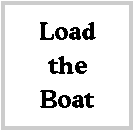 |
. .
4. Load the Boat
|
|
|---|---|---|
|
People Involved |
8 dancers | |
| START | Lines of four, with centers facing in, and the ends of each line facing the same (in or out) direction. | |
| END | 8-chain | |
| Movement | The end dancers move forward around the outside, passing right shoulders with three moving end dancers, and turn one-quarter in (90) to stand beside the third person passed, facing the center of the set as a couple. Simultaneously, the center four dancers Pass Thru, turn their backs to their momentary partners, Partner Trade with their new partners, and Pass Thru. | |
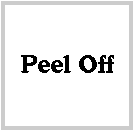 |
. . 5. Peel Off | |
|---|---|---|
| People Involved | 4 dancers | |
| START | one couple following another, box circulate or Z formation. | |
| END | line | |
| Movement | Each lead dancer turns away from the center of the starting formation, walks in a semi-circle and steps forward to become an end dancer of the new line. Meanwhile, each trailing dancer steps forward and does a U turn back, turning away from the center of the starting formation to become the center dancer of the new line. From one couple following another, the ending formation is a line of four; from a Z, the ending formation is a two-faced line; from a box circulate, dancers may have to take one step forward to adjust to a two-faced line. | |
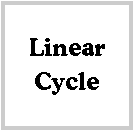 |
. . 6. Linear Cycle(from waves only)
|
|
|---|---|---|
| People Involved | 4 dancers | |
| START | wave | |
| END | facing couples | |
| Movement | (For programs other than Plus, allowable formations include any formation in which the end and adjacent center can single or partner hinge. This is a three part call.) Part 1. The ends and adjacent centers hinge. Part 2. Those facing out fold behind those facing in and all dancers will then move forward in a Double Pass Thru action. Part 3. If the hinge is right-handed, peel right; if the hinge is left-handed, peel left to end as facing couples. From a right-hand hinge, all will pass right shoulders. From a left-hand hinge, all will pass left shoulders. An added note just for information from beyond the Plus Program — From any inverted lines or some three in one lines, the passing rule shall prevail. (Not applicable in the Plus Program.) |
|
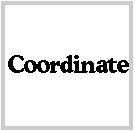 |
. .
7. Coordinate |
|
|---|---|---|
| People Involved | 8 dancers | |
| START | columns | |
| END | parallel lines | |
| Movement | All dancers Single File Circulate once and a half. The center six (three adjacent pairs) Trade (turn 180). The very center two dancers release handholds and walk diagonally outward to the end of the forming lines. The two lonesome dancers walk ahead, moving in a quarter circle, to become the other ends of the forming lines. | |
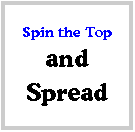 |
. . 8. (Anything) and Spread |
|
|---|---|---|
| People Involved | 4 or more dancers | |
| START | various | |
| END | various | |
| Movement | This call can be used in three ways: (1) If only some of the dancers are directed to Spread (e.g., from a static square, Heads Star Thru & Spread), they slide apart sideways to become ends, as the inactive dancers step forward between them. (2) If the (Anything) call finishes in lines or waves (e.g., Follow Your Neighbor), the centers anticipate the Spread action by sliding apart sideways to become the new ends, while the original ends anticipate the Spread action by moving into the nearest center position. (3) If the (Anything) call finishes in tandem couples (e.g., Wheel & Deal from a line of four), the lead dancers slide apart sideways, while the trailing dancers step forward between them. |
|
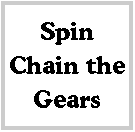 |
. .
9. Spin Chain the Gears |
|
|---|---|---|
| People Involved | 8 dancers | |
| START | parallel waves | |
| END | parallel waves | |
| Movement | Each end and the adjacent center dancer turn one-half (180). The new centers of each ocean wave turn three-quarters (270) to form a new ocean wave across the set, as the other four dancers do a U Turn Back (turning in toward the center). The centers of the wave Trade and then release hands with each other. Four dancers on each side of the square now form a four-hand star and turn the star three-quarters, forming a new wave across the set. Centers of this wave Trade momentarily reforming the wave across the set. The two outside pairs of dancers of the center wave now turn three-quarters (270) as the other four dancers turn back (turning away from the center). | |
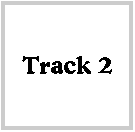 10. Track 2
10. Track 2
People Involved 8 dancers
START Completed Double Pass Thru.
END parallel waves
The dancers work in “tandem”, that is, the trailing dancers follow the lead dancers. Those in the right “track” move single file to the left, counter-clockwise, staying to the inside of the dancers on the left “track”, who move single file, clockwise, to the right on the outside. The movement continues as in a Double Pass Thru, until the dancers have reached parallel right-hand ocean waves.
